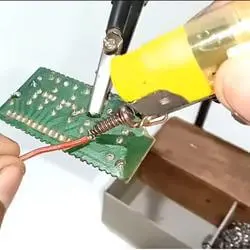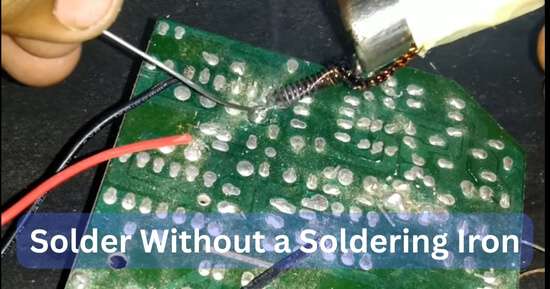Soldering is a technique for joining two or more metal surfaces by melting a filler material (solder) between them. A soldering iron is a standard tool to heat the solder and create a bond between the surfaces.
However, in some cases, a soldering iron may not be available or practical. In such situations, it is possible to solder without a soldering iron by using a heat source such as a lighter or a stove. Remember, soldering without a soldering iron can be difficult and may not produce as strong of a bond as soldering with a proper soldering iron.
Additionally, soldering without a soldering iron can be dangerous and should be done with caution. It is also recommended to use a soldering iron for the best results. In this guide, we will walk you through the process of soldering without a soldering iron step by step.
Table of Contents
ToggleHow to solder without a soldering iron?
Precautions to be followed while soldering
Precautions while soldering is given below:
- Wear Safety Goggles
- Soldering iron area never be touched with the hand
- Hold the heated wire with tweezers.
- Remember that the soldering iron always be put on the stand after using
- Keep the fire extinguisher with you, so you don’t have to face any problems and avoid danger.
- Do not leave the soldering iron plugged in after use.
Here is a general step-by-step guide for soldering without a soldering iron:
- Gather all necessary materials, including the items you wish to solder, a heat source (such as a lighter or stove), and soldering wire or solder paste.
- Clean the surfaces of the items to be soldered with a cleaning solution or sandpaper to ensure a strong bond.
- Apply the soldering wire or paste to the surfaces where the solder is needed.
- Hold the items to be soldered together and apply the heat source to the soldering wire or paste until it melts and creates a bond between them.
- Be extremely careful when using an open flame, as it can easily cause burns or start a fire.
- Use heat-resistant gloves or tongs to hold the parts while soldering.
- Keep the heat source moving to avoid overheating or burning the parts.
- Once the solder has cooled and hardened, inspect the bond to ensure it is secure.
Please note that soldering without a soldering iron is difficult and may not produce as strong of a bond as soldering with a proper soldering iron. Additionally, soldering without a soldering iron can be dangerous and should be done with caution. It is also recommended to use a soldering iron for the best results.
Ways of soldering without a soldering iron
Here is a detailed guide on soldering without soldering iron:
-
Solder by Heating the Wires Directly
The easiest way to heat the wire is by doing this, and the wire will heat up and become satiny so that you can solder easily; this is the most suitable and most manageable way that delivers you access to what you use as a soldering iron. you can solder it without soldering iron.
Now, you ought to heat the intersections of the wire you want to solder together. When the wool part becomes warm and soft, you have to fold it with the help of tweezers or something; then, by giving heat, you can solder without soldering iron.
Another thing that you should note is that you have to heat the separated wires for about 20 minutes so that we can apply the solder quickly and satisfactorily.
-
Solder With Scrap Metal
Another way is that you can solder with scrap metal. Assume you have to solder but don’t have a soldering iron. Then another key is to find scrap metal and solder with it. Don’t use the circuit board because the presence of the circuit board can become harmful to you. It is unfit to use a circuit board for this. Instead, you can use metal, old scissors, a wrench, etc.; using metal, old scissors, and a wrench is better than a circuit board.
Remember that if you use steel, it is an excellent choice because it has the property that it is strong and solders correctly while retaining heat. Copper can be used instead of steel, but this is not a good way to solder because copper does not stay hot for long. Using steel wire (at least 14 gauge), nails, screwdriver, bolts, multi-tool, and rebar is an excellent choice that gives you 100% soldering access.
-
Soldering With Heat Sources
For soldering, a soldering iron is required when using lighters and candles. 14 gauge steel wire is an excellent choice for soldering, with which you can easily solder. The reason for preferring 14 gauge steel wire is that it is shorter but heats up faster and provides more heat penetration.
As for heat soldering, the best solution is to solder the wire by heating it on a stove, and charcoal can help you solder a lot.
To solder with coal, place the soldered part on the coal and let it heat up. When the wire is hot enough to bend, overlap the part so that you can solder the solder.
Therefore, you can solder by giving heat from any source; in this way, the solder is also applied, and there is no need for soldering iron.
Types Of Soldering
There are three types of soldering
- Soft Soldering
- Hard Soldering
- Brazing
Conclusion:
In conclusion, soldering without a soldering iron is possible using alternative heat sources such as a lighter or stove. However, it is essential to note that this method can be complicated and may not produce as strong of a bond as soldering with a proper soldering iron.
Additionally, soldering without a soldering iron can be dangerous and should be done with caution. It is recommended to use a soldering iron for the best results. By following the step-by-step guide, you should be able to solder successfully without a soldering iron. Always take the necessary safety precautions and use heat-resistant gloves or tongs to hold the parts while soldering.
Related Guides:






